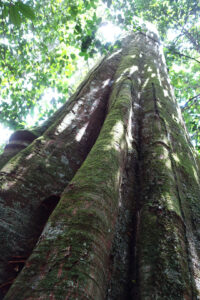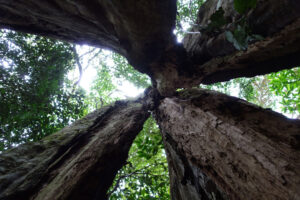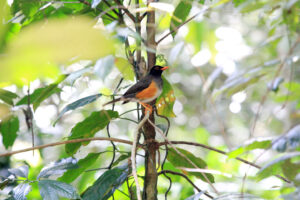John Mwacharo visits this special place and tells of gigantic trees, rare butterflies, endemic birds and special plants.
The cool of the forest is apparent as soon as we step into Ngangao Forest. An aura of mystique permeates our overgrown passage through moss and lichen-clad trees. It is mid-morning. The sun above makes its way west, its light streaking through the thick canopy. Against the background of many forest sounds are the calls of Cabanis’s Greenbul, Rüppell’s Robin Chat, and White-starred Robin. Walking in single file, we venture into the enchanting forest.
Ngangao Forest is the second-largest of very few surviving moist forest fragments of the Taita Hills. It is located 10 km from Wundanyi town and is home to many plants and animals, including some found only in these hills. We press through the forest walking on the leaves, broken twigs, bark and decaying branches that litter the ground to form a thick spongelike layer. We observe countless insects and other creatures scurrying on the forest floor. There are scattered understorey plants, wild mushrooms and colourful butterflies.
A trek through this magnificent forest is a magical experience, a moment to treasure. Today we are lucky. We are in the company of John Maganga, a seasoned community bird guide. Maganga’s many years of guiding visitors through Ngangao have nurtured a personal connection with the forest. His vast knowledge of the forest’s plants, birds and other animals are unparalleled.
“Ngangao Forest is our jewel. Some of the plants and birds found here are quite rare,” notes Maganga as he leads us through a narrow descending forest trail.
A few metres ahead of us stands a gigantic tree. We pause for a while and let our eyes feast on this natural marvel. Its towering 52 metres leaves us speechless.
“Welcome to the Ngangao mother tree!” announces Maganga.
I struggle to get a good photo of the entire tree. After several attempts, I give up. The mother tree is too big to fit into a single photo frame! I strain to catch a glimpse of its crown.

“This Newtonia buchananii is over 300 years old and not about to die anytime soon,” says Maganga.
Maganga goes on to say that, according to legend, the mother tree has mysteriously survived countless attempts to fell it, as evidenced by ‘cut’ marks on its ancient trunk.
After a couple of minutes of taking photos with the famous tree, we proceed to our next stop, a gigantic Aningeria adolfi tree. We are drawn to the tree’s hollow trunk that branches into three separate sections. The cavity, at its base, resembles a cave, big enough to fit two people.
“People here call this the cave tree,” Maganga explains.

Taking turns, we again pose for photos with this unique forest attraction. Moist forests once covered the Taita Hills. Over the years, these forests shrank into the existing scattered fragments on hilltops and ridges, that survive today. Gradual conversion of forest land to farms and settlements has over time led to this decline. Pressure from the dense human population surrounding the forests has left them extremely vulnerable.
Our adventure into Ngangao Forest with Maganga comes to an end after an hour or so. It has been an awe-inspiring journey of discovery into one of the area’s best-kept secrets.
Key species to watch for in Ngangao Forest
Crowned Eagle, Mountain Buzzard, Silvery-cheeked Hornbill, Striped Pipit, Taita Apalis, Evergreen Forest Warbler, Stripe-cheeked Greenbul, Yellow-throated Woodland Warbler, Taita White-eye, Orange Ground Thrush, Taita Thrush. Other special plants and animals include the small nocturnal Taita Mountain dwarf galago (found only in Taita Hills), the rare butterflies Papillio desmondi teita and Cymothoe teita; and wild coffee.

Visitor facilities at Ngangao Forest
The community manages an eco-resource centre and campsite in the forest. Community scouts stationed at the centre offer visitors guided tours at a small fee. For a spectacular view of Mount Kilimanjaro and the plains of Tsavo West National Park go to the viewpoint, located close to the forest. The best views are seen in the early mornings or late afternoons.
This article was first published in the Kenya Birding magazine, issue 16.
